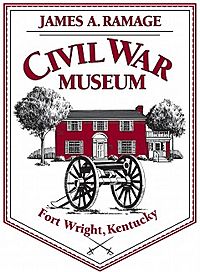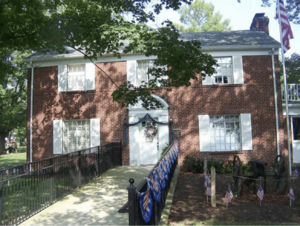James A. Ramage Civil War Museum facts for kids
 |
|
| Lua error in Module:Location_map at line 420: attempt to index field 'wikibase' (a nil value). | |
| Established | June 30, 2005 |
|---|---|
| Dissolved | August 25, 2021 |
| Location | Fort Wright, Kentucky, United States |
The James A. Ramage Civil War Museum was a museum in Fort Wright, Kentucky, United States. It focused on telling the story of how Cincinnati, Ohio, and Northern Kentucky were involved in the American Civil War. Even though no big battles happened right there, people in the area stopped a push by the Confederate army in 1862.
The museum was located at Fort Wright, Kentucky, on the site of an old defense spot called Hooper Battery. The museum grounds covered about 17 acres (69,000 square meters). It showed historical facts, stories, and items from the war. It also honored the Black Brigade of Cincinnati, a special kitchen from Fern Storer, and the history of Fort Wright city.
On August 25, 2021, the mayor of Fort Wright, Dave Hatter, ordered the museum to close. This happened after a year of talks with the museum's board about fixing problems with the building and its programs. Battery Hooper Park, where the museum was located, is still open for everyone to visit.
Contents
History of the Fort Wright Area
How the Land Became a Park
In 2004, the City of Fort Wright was asked by the Northern Kentucky University Foundation to buy some land. This land had been left to the NKU Foundation by its previous owners, Fern and Sheldon Storer. It sits on top of a hill that was very important during the Civil War.
Defending Cincinnati in 1862
This hill was one of the places where cannons and trenches were set up to help protect Cincinnati from about 8,000 Confederate soldiers. These soldiers were led by Maj. Gen. Henry Heth in September 1862.
Local men, including soldiers and everyday people, worked together to build a defense line. This line was over eight miles (13 kilometers) long. It stretched from Ludlow to what is now Fort Thomas. Their goal was to stop the Confederate invasion of Kentucky.
Under the command of Major General Lew Wallace, soldiers dug rifle pits and built dirt forts. They also cut down trees to create clear areas for shooting and used them as barriers against enemy soldiers.
Confederate Retreat
The Confederate soldiers marched to within a few miles of Fort Mitchel (now Fort Mitchell). They watched the defenses for two days. They decided that the defenses were too strong to attack. About 25,000 quickly gathered Union Army troops and 60,000 local militia were ready to fight. After some small fights on September 10 and 11 near Fort Mitchel, the Confederate invaders went back to Lexington.
Fern Storer's Home
The two-story house on the property was once the home of Fern Storer. She was a well-known food editor for the Cincinnati Post newspaper from 1951 to 1976.
About the James A. Ramage Civil War Museum
Creating the Museum Site
Fern Storer passed away in 2002. She left her house and 14.5 acres (58,679 square meters) to the Northern Kentucky University Foundation. Instead of selling the valuable hilltop land to builders, the NKU Foundation sold it to the City of Fort Wright for $790,000. City officials then announced plans to turn this historic site into a park. This park would focus on the area's Civil War history. The land where Hooper Battery was located is one of only six Civil War forts still existing in Northern Kentucky.
The City of Fort Wright was in charge of the Hooper Battery archaeological site. They received a $32,000 grant from the Scripps Howard Foundation to help with public digs and future restoration.
Honoring James A. Ramage
The museum was named after James A. Ramage. He is a retired history professor from Northern Kentucky University. He won many awards at the university, including Outstanding Professor of the Year in 1988.
In 2004, Professor Ramage received a grant to work on the Battery Hooper Project. The goal was to work with the City of Fort Wright. They wanted to involve students and the public in saving, researching, and opening Hooper Battery to everyone.
On June 30, 2005, the project finished with the opening of the museum on the site. The mayor and city council named the museum to honor Professor Ramage's hard work. By September 1, 2006, over 5,000 people had visited the museum. On December 9, 2007, Douglas Vonderhaar was celebrated as the museum's 10,000th visitor.
Museum Exhibits and Closure
In 2021, the museum started the Kentucky Underground Railroad Freedom Trail. This trail connects historic places and museums across Kentucky. It tells the story of the journey from slavery to freedom. The Ramage Museum had exhibits about African American heritage. These included the first African American military unit, the Black Brigade of Cincinnati, and Medal of Honor recipient Powhatan Beaty. Other African Americans who received the Medal of Honor for their Civil War service were also featured.
Exhibits also highlighted Underground Railroad conductor Harriet Tubman, Margaret Garner, and Maj. Gen. Lew Wallace. Wallace started the first Freedmen's Bureau in 1864. Several exhibits also showed the fight for women's right to vote and women who were important during the Civil War.
The museum was a small place run by volunteers. It played an important role in keeping local history alive. It taught visitors about unique Civil War events in the area, like the "Squirrel Hunters" and the Black Brigade. The museum closed on August 25, 2021, by order of Fort Wright's mayor.
Events and Activities
The museum accepted donations to help it operate. It also hosted different events. One of the most important events was the archaeological digs at Hooper Battery. Because the battery site had been filled with dirt, it was very well preserved. This gave people a chance to take part in archaeological activities and learn about history firsthand.
See also


